Posted by Anita on 08.10.09 8:13 PM
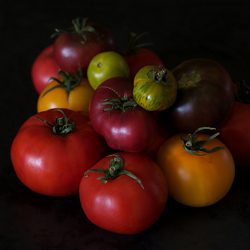 It’s finally happening: We’re finally harvesting enough fresh vegetables from our garden to make a meal, or most of one. True, this week we still bought tomatoes — although, look how gorgeous they are… can you blame us? By next week at this time, when our first branch of tomatoes is fully ripe, we’ll be able to make this recipe without much help from the farmers. This time around, we’re proud enough that half the bulk of our One Local Summer dinner for the week came straight from the yard.
It’s finally happening: We’re finally harvesting enough fresh vegetables from our garden to make a meal, or most of one. True, this week we still bought tomatoes — although, look how gorgeous they are… can you blame us? By next week at this time, when our first branch of tomatoes is fully ripe, we’ll be able to make this recipe without much help from the farmers. This time around, we’re proud enough that half the bulk of our One Local Summer dinner for the week came straight from the yard.
To celebrate this harvest milestone, I wanted to make sure that we found a recipe that wasn’t diluted with a lot of extraneous stuff. Looking at our bumper cucumber crop, I immediately though of Greek salad, but every recipe I found was almost half lettuce — which seemed a little counter to the occasion. Our lettuce patch is eking along pretty well in our mild coastal climate — we’ll have enough to spare for the BLT Challenge later in the month — but it seems a little sacrilegious to bulk up fresh tomatoes and cucumbers with a bunch of leaves. So I improvised a simple salad, and both of us were extremely happy with the results.
We served our garden bounty alongside a coil of grilled Basque-style sausage from our friends at Fatted Calf, and scooped everything up with a batch of homemade pita bread, made with a mix of locally grown whole-wheat flour (from Eatwell Farm) and locally milled Giusto’s bread flour. It was, if I dare say so, a feast fit for a Mediterranean deity.
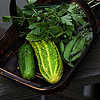



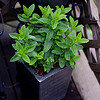
Greek Salad
3/4 pound tomatoes, cut into chunks (about 2 cups)
2 cups cucumber, peeled and seeded if desired, and cut into chunks
1/2 cup diced sweet red pepper
1/4 cup thinly sliced red onion
3 T extra-virgin olive oil
1-1/2 T red wine vinegar
3 T chopped Italian parsley
2 T fresh mint
1 T fresh oregano
1 T chives
—
1/4 cup crumbled feta cheese (about 2 ounces)
Toss all ingredients except feta in medium bowl to blend. Gently mix in cheese, and season with salt and pepper.
Farmers and food artisans who created the ingredients for this week’s recipe:
Lucero Organic Farms, Lodi: Heirloom tomatoes
Capay Fruits & Vegetables, Capay: red peppers
Catalán Family Farm, Hollister: Red onions
Bariani, Sacramento: Olive oil
O Olive Oils, San Rafael: wine vinegar
Spring Hill Cheese Company, Petaluma: Feta cheese
…and our homegrown cucumbers, parsley, mint, oregano, and chives
garden, locavore, One Local Summer, recipes
7 Comments »




Posted by Cameron on 05.23.09 8:55 PM
 A couple of weeks ago, I ended up talking to a reporter for the SF Chronicle for a story on urban gardening, and had a grand time bending her ear about my recent adventures. But after I rang off, my lovely and talented wife gently reminded me that our own home-grown publication hadn’t seen any garden news in… er… months.
A couple of weeks ago, I ended up talking to a reporter for the SF Chronicle for a story on urban gardening, and had a grand time bending her ear about my recent adventures. But after I rang off, my lovely and talented wife gently reminded me that our own home-grown publication hadn’t seen any garden news in… er… months.
Let’s see… where were we? In mid-January, everything in our newly built beds looked very promising: The radishes had sprouted, the onion sets were sporting little green mohawks, and the peas were “ready to wrestle a very tiny trellis into submission.”
But by mid-February, though the peas were still rocking and rolling, everything else had stopped growing. It was a completely pathetic sight: Rows of tiny green leaves surrounded by what looked like miles of grey-brown wasteland. By mid-March, the peas really did need some kind of trellis, but everything else was basically unchanged. I started to wonder if cold weather and frost had nuked my seedlings. Ridiculous, sure, but what did I know?
That was the start of a spring spent learning how to turn raw dirt and compost into a place where plants actually want to grow. I reconfigured the drip irrigation system three times, then watered by hand. I added more compost, cocoa bean mulch, fish emulsion, greensand, and finally a general purpose organic fertilizer. Basically, I followed the same approach as new parents confronted with a crying baby — “Is it thirsty? Is it hungry?” — except I was getting a lot more sleep.
I replanted the radishes and beets in what I hoped were more hospitable digs (ha!). But my thrill at the quick flush of new growth turned to fury as I realized that the new seedlings were being eaten down to the stem almost as soon as they emerged. As if that weren’t enough, I found that by filling raised beds with soft compost and soil, I had inadvertently opened a five-star refreshment facility for the neighborhood cats.
Imagine the thousand scenes where Clint Eastwood’s eyes narrow to a hard, weatherbeaten squint behind a loaded sixgun, and you’ve got a picture of my state of mind. The words “critter” and “varmint” entered my vocabulary. I closed the kitty spa by installing a low fence around the beds, but that didn’t stop whatever was chewing on the delicate sprouts. I embarked on nightly expeditions armed with a flashlight to try and catch insectile marauders in the act. That was the worst part: I couldn’t find any evidence of what was doing the damage. At last, I spotted a lone earwig scurrying across the beds late one night. Skeptical but desperate, I put out small tins full of beer as traps; after a couple of days, I was happy man. Those little prehistoric-looking summbitches loves them some suds, but they sure can’t swim a lick.
By this point it was April and though the peas were swarming up the second trellis I’d built (they didn’t like the first one — who knew that peas could be divas?), the rest of the plants looked like they’d survived a war. So I did the sensible thing: I planted more stuff that I’d never successfully grown before. Pickling cucumbers and cornichons took up residence in the beds. On the edges of the yard — in the sunniest, warmest spot along our northern fence — I put in St. Pierre and New Girl tomato plants, along with a brace of Kentucky pole beans around the corner. I adapted a yard composter to serve as a potato tower, populating it with seed potatoes that had returned with us from London. And although several of the cucumber plants didn’t thrive, everything else seems reasonably happy and healthy.
Back in November, when I first contemplated pulling up the slate tiles of our beautiful (though completely unused) patio and dropping a bunch of cash on wood, dirt, and compost, I slowed my racing heart by remembering that I had a lot to learn, that the first year of the garden would be a pure lark. Even so, I had no idea how difficult and how rewarding this project would be. On top of finding out basic stuff about what makes plants happy, I’m getting to know our back forty (feet) and its little ecosystem: Where the sun shines and where it doesn’t, what’s in the soil and what isn’t, and what sort of critters and varmints (good and bad) are crawling around.
One of the more amusing revelations that I’ve had along the way is that when it comes to our patch, nobody knows much more than I do. Last week, I decided that I wanted to put asparagus along the eastern fence line, but I was worried that it was too late in the season to plant the crowns. I fired off an e-mail to an expert source and got a response that boiled down to, “Sounds like a great idea! It might work…but then again it might not. Give it a try!” They say that in politics that if you want a friend, you should get a dog. In gardening, if you want certainty, get FedEx or get religion.
But the lack of guarantees may be what makes the harvest so special and satisfying. I still can’t quite believe it when I see the (very small) piles of radishes on the counter that went from seed to salad not thirty feet from the kitchen sink. I’ve got a long way to go, but the path ahead is one of the most inviting that I’ve ever seen. Every single peapod I munch tastes like victory.





garden
14 Comments »




Posted by Cameron on 01.06.09 10:09 PM
 It wasn’t easy to leave our newly planted crops germinating all on their lonesome as we took off for two weeks of well-deserved R&R on the far side of the Atlantic, but it was probably for the best. If nothing else, we were saved the agony of daily garden inspections in search of any signs of life. I briefly considered pointing a webcam at the back yard before we shuffled off to London, but discarded the idea after realizing that it would seriously creep out the housesitter, and that the camera’s resolution is so poor that I would be lucky to be able to pick out the raised beds, let alone any tiny green sprouts.
It wasn’t easy to leave our newly planted crops germinating all on their lonesome as we took off for two weeks of well-deserved R&R on the far side of the Atlantic, but it was probably for the best. If nothing else, we were saved the agony of daily garden inspections in search of any signs of life. I briefly considered pointing a webcam at the back yard before we shuffled off to London, but discarded the idea after realizing that it would seriously creep out the housesitter, and that the camera’s resolution is so poor that I would be lucky to be able to pick out the raised beds, let alone any tiny green sprouts.
So we returned from Albion with zero information, but plenty of hope. We dropped our luggage, played with the dogs for a minute or two, and then raced out to see if our backbreaking labor (ha!) had shown results. Happily, it had.
The radishes have come up like absolute gangbusters, sprouting delicate green tops and putting everything else to shame. The pea vines are running a close second, with two lines of tough, wiry — and at less than half an inch tall, seriously cute — stems that already look like they’re ready to wrestle a very tiny trellis into submission. The mixed lettuce is up and it’s kind of amazing to see how different all the different types look already, even though the largest leaf can’t be more than two millimeters across. A few of the onion sets are showing signs of life, and we even have a couple of green sparks showing in the leek trench.
So far, the laggards are the onion seeds and the beets. I’m not holding my breath on the former — everything that I’ve read says that onions are tough to grow from seed and that even when they are successful they take forever to germinate. I’m a bit puzzled about the beets, as they’re supposedly unfazed by cool weather, but it’s still pretty chilly at night and the seeds have only been in the ground for 20 days, 15 hours, and 33 minutes. But who’s counting?
And yes, that is frost that you see on the seedlings in the pictures. The Sunday morning after our first night back arrived with a coating of frozen crystals. A few days later, none of the little ones seem any the worse for wear. Since then, I’ve also discovered that I can stop frost from occurring at all simply by covering the plants to protect them — much the way that carrying an umbrella prevents rain from falling. Me and my magical frost cover are available for weddings, birthdays, and bar mitzvahs.





garden
8 Comments »




Posted by Anita on 12.23.08 3:27 AM
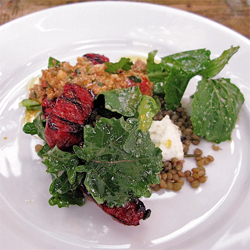 Here’s a recipe for a magical midwinter’s afternoon: Take the Tube to Richmond, a village on the fringes of London, then hop a red double-decker bus for a ride along the Thames. Alight in front of the cheery half-timbered pub, walk down the church lane past the Celtic stone crosses, left at the split-rail fence, and bob’s your uncle: You’ve arrived at Petersham Nurseries.
Here’s a recipe for a magical midwinter’s afternoon: Take the Tube to Richmond, a village on the fringes of London, then hop a red double-decker bus for a ride along the Thames. Alight in front of the cheery half-timbered pub, walk down the church lane past the Celtic stone crosses, left at the split-rail fence, and bob’s your uncle: You’ve arrived at Petersham Nurseries.
Now, even if an afternoon at a garden centre is not your idea of holiday time well spent, bear with me. Remember that the English excel at creating magical places, at planting beautiful gardens, at the eternal joy that is lunchtime. So it should come as no surprise that a mid-day repast inside a converted greenhouse — complete with dirt floors, mismatched chairs, and waitresses wearing muckboots with skirts — would be just the sort of adventure that would pay off very handsomely indeed.
Take your seat under the heater, and start with the seasonal sparkler — say, vanilla-rhubarb prosecco — then pick an appetizer to share. (If the chorizo starter with with lentils, caprini fresca, and agresto is on the menu, please order it; you won’t be sorry.) Pick your mains from a short list, one of which always seems to be vegetarian and another fish. Chef Skye Gyngell’s team “sources the best-quality seasonal ingredients that we can lay our hands on”, so you might opt for a whole roasted partridge with farro, chard, and salsa verde, or perhaps a fillet of sea bass served with clams, fino, arrocina beans, and aioli. Make sure to save room for dessert: The hazlenut tart comes with a generous drizzle of chocolate sauce and a dollop of airy crême fraiche.
Should you need to freshen up, you’ll find the loos in the hobbit-like wooden structure that houses the cafe kitchen and the teahouse. The latter — if you’ve neglected to book ahead, or just fancy a lighter nosh — offers a daily soup served with good bread and a hodgepodge of sweet cakes. And tea, of course. Always tea.
The nursery yard itself is full of all sorts of treasures, so if you’re a gardening buff — or, really, even if you aren’t — be sure to budget enough time to stroll and browse. The last lunch reservation is taken at 2:45, but the retail side remains open until 5pm, although in the dwindling light of wintertime you might plan to come early rather than stay late.
Bundle up and stroll back down the lane to the bus stop, where the diamond-paned windows of the pub now glow with holiday cheer. Your bus will be along promptly — this is England, after all — ready to whisk you back up the hill to Richmond and the real world… full, happy, and content.
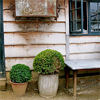



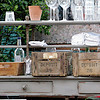
Petersham Nurseries & Cafe
Church Lane, off Petersham Road
Richmond
Surrey TW10 7AG
020 8940 5230
garden, locavore, London, lunch, restaurants, travel
3 Comments »




Posted by Cameron on 12.16.08 1:46 PM
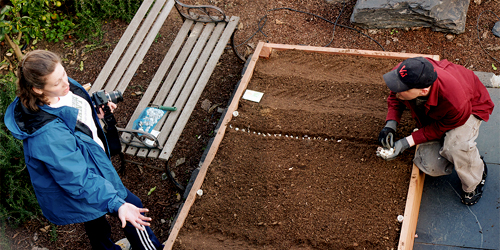
I have never been an instinctively organized person. I tend to leave planning until the last minute, overestimate (and overbuy) the necessary materials, and then fly by the seat of my pants. Most of the time my “method” works, but it can be wasteful. It’s also hard to define and evaluate what I did in retrospect, so that I can do it better next time.
I have been trying like heck not to take my typical approach with our nascent vegetable garden. From the construction of our new raised beds (hammer and shovel account coming in a future post, I promise) to planning plantings, I have actively encouraged my inner project manager to come out and play.
However, I am acutely aware of the fact that what I consider a “plan” often sounds like Marty McFly’s instructions to the 1950s dance band in Back to the Future: “Okay guys, this is a blues riff in B. Watch me for changes and try and keep up, okay?” So when Genie, aka the Inadvertent Gardener, volunteered to lend a hand with our very first planting, I was primed to overthink the entire event. And boy, did I.
I read all of the instructions on the seed packets, inside and out, cross-referencing the information with my two new best friends, Pam Peirce’s Golden Gate Gardening and Jeff Ball’s 60-Minute Vegetable Garden. I gazed at our new beds, making calculations about relative amounts of sun and shade, and searched the Web for general planting instructions, raised bed ideas, and wide-row planting theory. I made a list of the vegetables that I wanted to grow, organized by the distance between rows that each required. I drew up a small diagram of my beds (to scale, of course), illustrating what would go where. And, when Genie asked what time she should arrive on Saturday, I thought about how much time planting might take and left a generous margin for error, suggesting that I pick her up from the BART station at 1pm.
Saturday morning, I laid out all of my garden tools (a shovel, a long rake, a hand trowel, and a hand rake) and the seed packets, clipped together. It wasn’t until Genie arrived and I started describing the work plan — illustrated with my hyperactive little meth-junkie diagram — that I started hearing the loose screws rattling around in my tiny little head. I hauled in the reins and ground to a halt, biting off the suggestion that we measure the distance between rows. Folks, we’re talking about two small raised beds, each almost exactly eight feet long and four feet wide; surrounded by and aligned with stone tiles that are each almost exactly two feet square. About the only thing that we didn’t have to work with was a grid printed directly on the dirt. Somewhat sheepishly, I handed Genie a rake and suggested that we start loosening the soil in the beds, which had settled and crusted over a bit in the two weeks since I installed them.
About an hour later, I was feeling like an even bigger dork. The planting that I thought would take most of the afternoon? Done. Actually, Genie finished her bed in about 30 minutes and spent the rest of the time taking pictures of me stumbling about. Right now, somewhere, my über-gardener mom is looking down on me and laughing her butt off. With love, sure. But laughing nonetheless.
But you know what? We now have a bunch of dirt with seeds in it! We’ve got three kinds of onions in (two from seed and one from sets) — some that I’m planning to pull as scallions. We also planted three rows of mixed beets, two rows of French breakfast radishes and another of cherry radishes, a row of leeks, two of peas, and one of mixed lettuce.
And to tell the truth, I could use more “chore” days like this one. Anita made delicious lunch of Reuben sandwiches with Marin Sun Farms pastrami, which we ate with Laura’s dilly beans and Sean’s pickles. We spent the rest of the afternoon talking, playing with the pups, sipping beer, and kibitzing in the kitchen.
After the sun went down, the three of us washed our faces, put on our city duds, and headed off to SPQR, where red wine, non-stop wisecracks, at least six different kinds of pork, and a surprise fireworks display (seen across the bay from the top of Fillmore Street as we waited for our table) were the order of the evening. If there’s a better, happier, more karmically charged way to kick off a new garden, I cannot imagine what it would be.



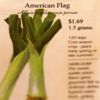

garden, other blogs
11 Comments »




Posted by Anita on 12.07.08 2:26 PM
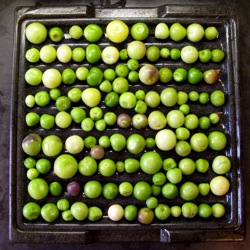 Last weekend, I went through both freezers — the little one in the kitchen, and the slightly larger one in the garage — and inventoried their contents. I didn’t discover any huge surprises in either location, thankfully, but I did turn up a few odds and ends that would be better to eat now rather than later. And since we needed to make room for half a turkey’s worth of meat, a little reorganization was in order.
Last weekend, I went through both freezers — the little one in the kitchen, and the slightly larger one in the garage — and inventoried their contents. I didn’t discover any huge surprises in either location, thankfully, but I did turn up a few odds and ends that would be better to eat now rather than later. And since we needed to make room for half a turkey’s worth of meat, a little reorganization was in order.
In addition to the pickles and broth I put up last weekend, I also made a big batch of tomatillo-sauce base to freeze: I roast and puree chiles and tomatillos, then add onions and simmer it down. Right before I’d usually add poultry broth and re-reduce to make a sauce, I cool down the paste and portion it out for the freezer. When I want to make enchiladas or chile verde, I thaw a brick, add the missing liquid, and finish the recipe.
 The two big Dark Days meals we cooked at home took care of some freezer odds and ends, and used the last of the un-frozen Thanksgiving leftovers, too. On Monday night, we whipped up a batch of our favorite stacked enchiladas with a little of the tomatillo sauce I’d set aside, along with a half-packet of tortillas and container of Rancho Gordo beans from the freezer, and the last bits of meat left over from turkey sandwiches. Later in the week, Cameron made a delicious beef-and-ale stew using a pound of Marin Sun chuck we’d stashed away from an early CSA box. Topped with the last of the Thanksgiving mashed potatoes, the stewmade a very decadent sort of cottage pie.
The two big Dark Days meals we cooked at home took care of some freezer odds and ends, and used the last of the un-frozen Thanksgiving leftovers, too. On Monday night, we whipped up a batch of our favorite stacked enchiladas with a little of the tomatillo sauce I’d set aside, along with a half-packet of tortillas and container of Rancho Gordo beans from the freezer, and the last bits of meat left over from turkey sandwiches. Later in the week, Cameron made a delicious beef-and-ale stew using a pound of Marin Sun chuck we’d stashed away from an early CSA box. Topped with the last of the Thanksgiving mashed potatoes, the stewmade a very decadent sort of cottage pie.
We spent some time this weekend getting the garden ready for fall, pruning the fruit trees and cutting back the hardy herbs like rosemary. I ended up with enough cuttings to make a few rustic wreathes. Contrary to my romantic notions, wreath-making can be a messy, sticky job (your hands end up covered in a pine-like sap!) but I think the end result was worth it. I now have pretty holiday decorations with a lovely scent, and afterward the sprigs can be stripped to use in cooking.
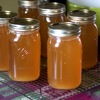



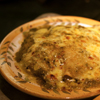
Where’s the recipe??
We’re experiencing some technical difficulties — our blog server is running painfully slow, and it was all we could manage to get this post up in time for the Dark Days roundup before running off to not one but two holiday parties this evening. If you’re interested in Cameron’s recipe for the Beef Braised in Ale, check back early next week.
Beef in Ale
– adapted from The River Cottage Meat Book
3# boneless chuck or stewing beef, trimmed and cut into 2-inch chunks
8 ounces pancetta or bacon, cut into 1-inch pieces
2 T butter or drippings
1 pound of onions (Hugh specifies baby onions, peeled and left whole. I used medium-sized yellow onions, quartered)
Up to 1/3 c all-purpose flour, seasoned with salt and pepper
4 cups ale (Hugh calls for stout)
2 bay leaves
1 sprig thyme
A few stems of parsley
8 ounces each of carrots and celery, cut into chunks
Heat the butter or drippings in a Dutch oven or other large stew pot and render the pancetta or bacon over medium heat, cooking until well-browned. Remove the bacon with tongs or slotted spoon and reserve on a plate. Fry the onions in the hot fat until they are lightly browned all over. Remove the onions and add to the bacon on the reserve plate. Turn up the heat to medium-high or high depending on your stove. Toss the beef in the seasoned flour and shake/pat off as much of the excess as possible, leaving only a fine layer of flour behind.
Working in batches, thoroughly brown the beef on all sides, removing it to the reserve plate when you dare not leave it in any longer. Here is where your diligence in flour removal will pay off. The browner you can make the beef chunks, the better your stew will taste, but extra flour will flake off and burn before you can get the beef where you want it.
Pour in some of the ale and deglaze the pot, scraping up the browned bits with a wooden spoon. Tip the contents of the reserve plate (bacon, onion, beef, and any juices that have collected) into the pot. Pour in the rest of the ale, adding water if necessary to just cover the meat. Add the herbs, tied into a bouquet garni. Taste and season lightly with salt and pepper, keeping in mind the saltiness of your bacon and the fact that you will be reducing the liquid. Bring to a boil and set to simmer gently with the lid on but slightly ajar.
The stew will need to cook roughly 2-1/2 hours. This can be done either on the stovetop or in an oven set to 250° F. If the meat starts to get exposed, add a little hot water. Approximately one hour before you expect the meat to be done, add the carrots and celery. You’ll know it’s done when the meat falls apart at the touch of a fork.
Remove the bouquet garni. Taste again for seasoning and serve under, over, beside, or puddled in potatoes that have been mashed with scandalous amounts of cream and butter.
Dark Days challenge, garden, locavore, recipes
8 Comments »




Posted by Anita on 11.23.08 11:55 PM
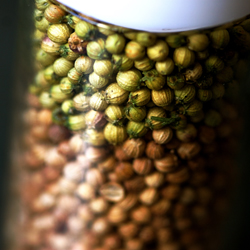 I was going to title this post “Last harvest”, but then I realized — even in our fairly seasonal garden — that our harvest never really ends. The lemon tree is ever-bearing, and is coming into its peak fruit-picking season. The bergamot is busting out all over; it dropped a fruit today — which is almost certainly hollow, but plenty good for making one of our favorite liqueurs.
I was going to title this post “Last harvest”, but then I realized — even in our fairly seasonal garden — that our harvest never really ends. The lemon tree is ever-bearing, and is coming into its peak fruit-picking season. The bergamot is busting out all over; it dropped a fruit today — which is almost certainly hollow, but plenty good for making one of our favorite liqueurs.
Our makrut (kaffir lime) tree is growing so large that it needs a fairly major pruning; when that happens, we’ll have enough aromatic leaves and fruit to supply a small Thai village. And although the lemon verbena is dying back to its canes, the plum tree has gone dormant, and the basil is long-since gone to seed, we’ll have most of our herbs — thyme, oregano, and sage — through the dark days.
Today we tackled two garden-related tasks: One in the kitchen, to put up a few bits of the 2008 season, and one at the lumber yard, to lay the ground work for 2009. Early in the day, I picked and sifted through piles of coriander and fennel seed, which I’d set aside a few weeks ago to dry. As you can see from the photo above, the color contrast between home-grown seeds — even when fully dry — and store-bought is fairly dramatic; the scent and flavor are even more astounding.
Later in the afternoon, we headed off to the suburbs in search of redwood decking. We’ve finally decided — after two years of avoiding reality — that our pretty patio is a luxury; even in our sunny ‘hood, we aren’t able to entertain outdoors more than a few times a year. So Cameron pulled out the gardening books, mapping out a plan to replace some of the slate pavers with raised garden beds. (I’m hoping he’ll pop by soon to tell you more about his construction plans and maybe even share his planting diagrams.)





Dark Days challenge, garden, locavore
7 Comments »




Posted by Cameron on 07.28.08 10:01 PM
 Sweet spirits of niter, did we get plums this year or what? Last year, our little whip of a tree served up a double dozen of the sweetest, tartest, juiciest globes that we could have ever hoped for. This year, that little whip filled out and buried us under an avalanche of purple fruit.
Sweet spirits of niter, did we get plums this year or what? Last year, our little whip of a tree served up a double dozen of the sweetest, tartest, juiciest globes that we could have ever hoped for. This year, that little whip filled out and buried us under an avalanche of purple fruit.
We saw Plumapalooza coming when we had to prop up one of the tree’s lower branches. The load of ripening plums bent it into a wicked arch, forcing the tip down so far that it touched the ground. However, it’s one thing to gaze admiringly at branchloads of red and purple glory. The reality of harvest is another thing entirely.
Toward the end of June, the very first volunteers hit the ground. Every day, we would gather the fallen and tug gently at likely followers still hanging on the branch. Five a day turned into ten and in a week’s time, we were gathering up between fifteen and twenty plums every morning and every night. By the time it was all over, we figured that we reaped 30-40 pounds of fruit.
Which naturally begged the question of precisely what the hell we were going to do with 40 pounds of plums. Finding a solution seemed especially pressing in the early stages of the deluge as we carefully picked yard bark out of drops and sorted the fruit into piles of Perfect, Not-so-perfect and We-love-you-anyway on the countertop. Ultimately, we knew that we would have to turn to preserves or some other solution that involved canning, but we weren’t ready to go there just yet.
As I stood in the kitchen one weekend, chain-eating plums and staring at the latest load, Anita reminded me that I had talked about making pâte de fruits before the plums started thumping down. Brilliant! Why didn’t I think of that? I checked around and found a few recipes, most of which called for pectin, but Anita sussed out a recipe in the San Francisco Ferry Plaza Farmers Market Cookbook that was nothing but plums, a little lemon juice, and a *lot* of sugar.
My first go at being a candy maker turned out pretty well, but there were some bumps along the road, mostly related to the fact that the recipe instructions about how long to cook the plum/sugar mixture before pouring it into a pan to set didn’t match up with my real-world experience: “Cook over low heat, stirring constantly, until the fruit reduces and thickens and begins to hold together as a mass, 20 to 30 minutes.”
Obvious, right? Easy? Not for this knucklehead. I stood in front of the stove stirring that pot nonstop for THREE FREAKING HOURS while the contents went from a thin purple soup to a bubbling syrup that I — exhausted and convinced that I had made a fatal error somewhere — finally abandoned to the tender mercies of the candy pan.
On behalf of my fellow kitchen idjits, let’s diagnose the sentence that was my nemesis. Cook over a low heat? My friends, it’s probably possible to boil a pot of coffee with a Bic lighter, but it’s going to take a long damn time, and when you’re trying to evaporate a quart or so of liquid, you need something a bit more brisk than low heat. Next time, I’ll be less tender with the flame during the early proceedings.
Second lesson: use a comfortable spoon. For reasons that are now unclear to me, I chose a metal spoon for my stirring utensil (Something to do with not staining the wooden spoons? Maybe? I don’t know. Leave me alone.). All I know is that after several hours of making like the witches in Macbeth, the unforgiving handle had given me a blister.
Last point: I don’t know about you, but when I think of something “holding together as a mass,” I expect to be able to haul out a serious hunk of glop when I raise up the spoon. Au contraire, mon frere. My pot full of plum sweetitude thickened to a syrupy consistency and then stopped. I kept at it, though, stirring away like Jamie Oliver on Quaaludes until I smelled the sugar caramelizing and thought to myself, “Self, if you keep going, you’re going to end up with plum-flavored Jolly Ranchers. If it ain’t done now, it ain’t gonna be done.”
It was done. After setting, cooling, cutting, and dusting with sugar, the final product was chewy, tart, and had the unmistakable twang of sugar that’s had a comfortable and extended acquaintance with the flame. It was good, and the piles of plum candy disappeared more quickly than I would have believed possible, especially when paired in gift bags with Anita’s homemade marshmallows.





Plum Candy
– adapted from the San Francisco Ferry Plaza Farmers Market Cookbook
4 pounds plums, pitted and chopped
2 T water
Juice of 1/2 lemon
About 4 cups sugar
In a large, heavy enameled cast-iron or other nonreactive pot, combine the plums, water, and lemon juice. Place over low heat and cook until the fruit is very soft, about 20 minutes.
Remove from the heat. Puree the plum mixture by forcing it through a fine-mesh sieve or food mill fitted with a fine screen held over a bowl. Measure the puree, return it to the pan, and stir in an equal amount of sugar. Cook over low heat (ha!), stirring constantly (ow!), until the fruit reduces and thickens and begins to hold together as a mass, 20 to 30 minutes (bullshit. see above.).
Line a 9-by-12 inch rimmed baking sheet with parchment (the original recipe says plastic wrap, but I was afraid that it would melt) overlapping the edges. Pour the plum paste onto the lined pan and spread into an even sheet with a rubber spatula. Let cool, cover, and allow to stand at room temperature for 48 hours. The paste will become firm.
Invert the pan onto a cutting board, peel off the parchment, and cut the paste into about 36 small squares. Arrange in layers on waxed paper and store in an airtight plastic container at room temperature.
dessert, garden, locavore, preserving & infusing, recipes
23 Comments »




Posted by Cameron on 09.19.07 11:49 AM
 Like we needed more herbs.
Like we needed more herbs.
Seriously, we’ve got thyme, rosemary, and oregano in the yard (and by the yard), probably the three most useful fresh herbs to have within easy clipping distance. Adding to that could be viewed as extravagance, piling on, perhaps even hubris. So why do we have a window box outside our breakfast room sprouting green leaves and stalks?
It all started in July with a bunch of sweet basil that Anita brought home from the farmer’s market. She used what she needed and stuck the rest in a glass of water on the kitchen windowsill, where we ignored it for two weeks. We must have added water at regular intervals, because the glass wasn’t all that big, but I don’t remember doing it or seeing Anita do it. It got less attention than a bald white guy at a dim sum parlor.
Darned if that bunch of basil didn’t grow roots and stay all green and lush and everything.
So about the time that we’re watching these stalks get their groove on in about a cup and a half of Hetch Hetchy’s finest, we start thinking that the view out the window of our breakfast room is a little stark. Which is not exactly a penetrating observation given that the window faces an expanse of painted plywood about eight feet away. This was also right about the time when the main garden was popping along in full summer bloom, and I was thinking that maybe I could see a faint tinge of green around the edges of my thumbs. Yes, even after I washed them. Smartass.
Anyway, I figured that if we gave this little survivor of a basil plant some dirt and a little love, we’d really see something. At the same time, a window box would be just the thing to spruce up the view. So I split the bunch of basil in two and planted half down in the yard near the bergamot tree. The other half I put in a window box along with some tarragon, chives, and Thai basil.
So far, the box has succeeded both as a still life and a food source. A little bit of the tarragon goes a long way, but it gave the sauteed potatoes that we made for our Julia Child dinner just the right touch. The chives have made cameo appearances in several dishes (including those same potatoes), and the Thai basil dropped in on one of our standby stir-fries last week.
The basil is still growing, but slowly; it’s a living demonstration of how my enthusiasm for gardening occasionally outstrips any calculations of practicality. As I’ve discovered, basil isn’t generally the sort of thing that you just pick a leaf or three off now and again. If you’re serious about consumption, you grow it in big bunches for regular harvest.
But honestly? I really don’t care. I know that I’ll have to plot (heh heh) and plan if I want to try a real vegetable garden… even a small one. In the meantime, it’s a thrill just to plant something green and watch it thrive. It feels like a promise that I’m making to myself.
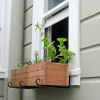
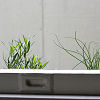

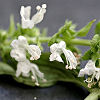

Pommes de Terre Sautées
adapted from Mastering the Art of French Cooking
2 pounds “boiling” or new potatoes
2 T butter plus 1 T oil, for sauteeing
2 to 3 T softened butter
1/4 tsp salt
2 to 3 T minced fresh green herbs (parsley, chives, tarragon)
Peel the potatoes. As you do, try and make them as smooth as possible and give them an oval shape that may remind you of extremely large olives or impossibly small rugby balls, depending on how you spent your formative years. Do not wash the potatoes after peeling; pat them dry with a clean towel. If you need to hold the raw potatoes for a while before you cook them, wrap them in a damp towel, and then dry them before cooking.
Add the butter and oil to a skillet and heat it over medium high. When the butter stops foaming, put the potatoes in and leave them for two minutes. Control the heat so that the butter/oil mixture stays hot but does not color. Shake the potatoes in the skillet, rolling them around and letting them sit to sear until they are pale gold all over.
Sprinkle the salt over the potatoes, lower the heat, cover the skillet, and cook the potatoes for 15 minutes, shaking them every three or four minutes to prevent sticking. When the potatoes yield to slight pressure from your finger or when a knife pierces them easily, use the skillet cover to hold in the potatoes while you pour off the fat.
Take the potatoes off the heat, add the softened butter, herbs, and a few grinds of fresh black pepper. Shake the potatoes in the skillet so that they glisten with herbs and butter. Serve immediately.
cookbooks, garden, recipes
4 Comments »




Posted by Cameron on 08.06.07 10:28 PM
 Okay, honest, I never intended for this garden tour to become a summer-long thing. I started in June, figured that I’d post a few times and be done by early July. Now here it is August already. Where do the days go?
Okay, honest, I never intended for this garden tour to become a summer-long thing. I started in June, figured that I’d post a few times and be done by early July. Now here it is August already. Where do the days go?
For those of you just joining us, this is the third installment of a tour of our backyard, which we reclaimed from ugly ignominy just over a year ago. In our last episode, we braved the Northside Fruit Preserve and the Eastern Wall. What adventures lie ahead?
On the south side of the yard, we see the fence that separates the garden from the dog run. Until mid-June, it was blanketed in passion fruit vines that seemed like a good idea when we planted them. However, “fast-growing and aggressive” does not begin to describe these guys. After only a single year, two plants completely covered a 25-foot fence and needed to be trimmed practically every day. After being grimly and colorfully assured that we hadn’t seen anything yet, we decided to eliminate the vines before they ate one of the dogs.
However, we’re not sure that we haven’t forsaken the frying pan for the fire. In the place of the passion fruit, we installed four Golden hop vines purchased from the farmer’s market. We’ve always wanted to grow hops, but have never had the motivation, garden space, season, and rhizomes come together at the same time. Planted in late June, the hops have already enthusiastically twined through the fence and are waving feelers around above the rail line. But for some reason, I feel more kindly toward these particular fast-growing, aggressive vines than I did the passion fruit.
Theoretically we could use the hop flowers to make beer, but it’s more likely that we’ll take the advice a passerby at the market gave us as we were buying the plants. Apparently, hop-shoot risotto is a done thing in some parts of Italy (and elsewhere?). If you have any recipes, please share!
In front of the south fence, we have line of herbs (two thyme plants, one oregano, and one sage plant) that define the most serious, working part of our garden. We’re down there clipping fresh bits for cooking at least once a week. Our herb crew has battled through adversity: the oregano fell prey to a mite infestation last year, and our original variegated sage plant died shortly after it was planted. But the oregano has come bounding back, and we recently replaced the sage. Everything is growing like gangbusters, especially the thyme.
The fact is, “growing like gangbusters” describes everything that we’ve put in — a state of affairs that I attribute to the gentle microclimate that favors our patch. When we originally planned the yard, I chose plants that would produce food, but that wouldn’t require much tending. But now, flushed with success, I’ve found myself contemplating a true vegetable garden. A small one, mind you.
In the meantime, the sun is out, and there’s a chair on the patio near the magnolia with a good book and a tall, cool glass of something refreshing waiting for me.





garden
4 Comments »




 It’s finally happening: We’re finally harvesting enough fresh vegetables from our garden to make a meal, or most of one. True, this week we still bought tomatoes — although, look how gorgeous they are… can you blame us? By next week at this time, when our first branch of tomatoes is fully ripe, we’ll be able to make this recipe without much help from the farmers. This time around, we’re proud enough that half the bulk of our One Local Summer dinner for the week came straight from the yard.
It’s finally happening: We’re finally harvesting enough fresh vegetables from our garden to make a meal, or most of one. True, this week we still bought tomatoes — although, look how gorgeous they are… can you blame us? By next week at this time, when our first branch of tomatoes is fully ripe, we’ll be able to make this recipe without much help from the farmers. This time around, we’re proud enough that half the bulk of our One Local Summer dinner for the week came straight from the yard.




















































 Like we needed more herbs.
Like we needed more herbs.




 Okay, honest, I never intended for this garden tour to become a summer-long thing. I started in June, figured that I’d post a few times and be done by early July. Now here it is August already. Where do the days go?
Okay, honest, I never intended for this garden tour to become a summer-long thing. I started in June, figured that I’d post a few times and be done by early July. Now here it is August already. Where do the days go?



